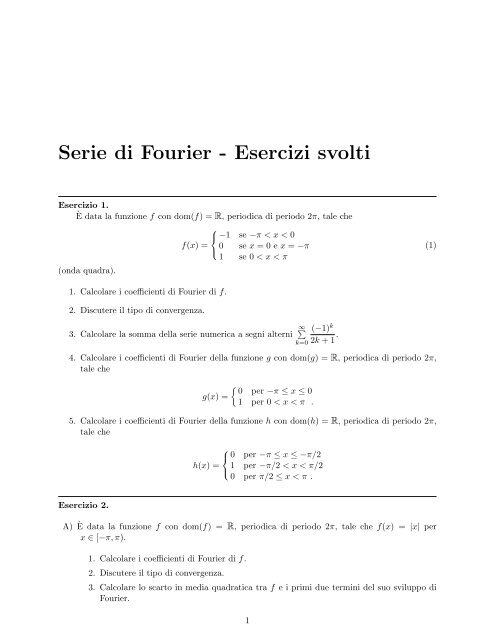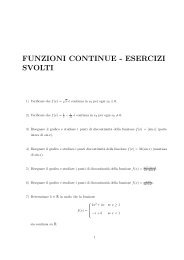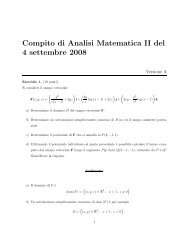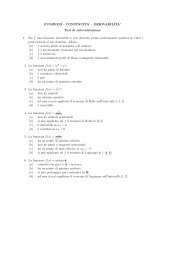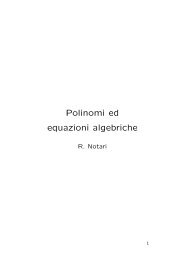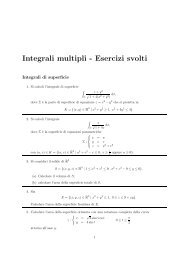Serie di Fourier - Esercizi svolti
Serie di Fourier - Esercizi svolti
Serie di Fourier - Esercizi svolti
- No tags were found...
Create successful ePaper yourself
Turn your PDF publications into a flip-book with our unique Google optimized e-Paper software.
<strong>Serie</strong> <strong>di</strong> <strong>Fourier</strong> - <strong>Esercizi</strong> <strong>svolti</strong><strong>Esercizi</strong>o 1.È data la funzione f con dom(f) = R, perio<strong>di</strong>ca <strong>di</strong> periodo 2π, tale che(onda quadra).⎧⎨ −1 se −π < x < 0f(x) = 0 se x = 0 e x = −π⎩1 se 0 < x < π(1)1. Calcolare i coefficienti <strong>di</strong> <strong>Fourier</strong> <strong>di</strong> f.2. Discutere il tipo <strong>di</strong> convergenza.3. Calcolare la somma della serie numerica a segni alterni∞∑k=0(−1) k2k + 1 .4. Calcolare i coefficienti <strong>di</strong> <strong>Fourier</strong> della funzione g con dom(g) = R, perio<strong>di</strong>ca <strong>di</strong> periodo 2π,tale cheg(x) ={ 0 per −π ≤ x ≤ 01 per 0 < x < π .5. Calcolare i coefficienti <strong>di</strong> <strong>Fourier</strong> della funzione h con dom(h) = R, perio<strong>di</strong>ca <strong>di</strong> periodo 2π,tale che⎧⎨ 0 per −π ≤ x ≤ −π/2h(x) = 1 per −π/2 < x < π/2⎩0 per π/2 ≤ x < π .<strong>Esercizi</strong>o 2.A)È data la funzione f con dom(f) = R, perio<strong>di</strong>ca <strong>di</strong> periodo 2π, tale che f(x) = |x| perx ∈ [−π, π).1. Calcolare i coefficienti <strong>di</strong> <strong>Fourier</strong> <strong>di</strong> f.2. Discutere il tipo <strong>di</strong> convergenza.3. Calcolare lo scarto in me<strong>di</strong>a quadratica tra f e i primi due termini del suo sviluppo <strong>di</strong><strong>Fourier</strong>.1
2 SERIE DI FOURIER - ESERCIZI SVOLTI∑4. Calcolare la somma della serie numerica ∞ 1k=0 (2k + 1) 2 .5. Calcolare i coefficienti <strong>di</strong> <strong>Fourier</strong> della funzioneg(x) ={ π + x per −π < x ≤ 0π − x per 0 < x ≤ π .B) Si consideri quin<strong>di</strong> la funzione ϕ definita su tutto R, perio<strong>di</strong>ca <strong>di</strong> periodo 4, tale che ϕ(x) = |x|per x ∈ [−2, 2).1. Calcolarne i coefficienti <strong>di</strong> <strong>Fourier</strong>.2. Usando l’identità <strong>di</strong> Parseval, calcolare la somma della serie numerica ∞ ∑k=01(2k + 1) 4 .<strong>Esercizi</strong>o 3.È data la funzione f, con dom(f) = R, perio<strong>di</strong>ca <strong>di</strong> periodo 2π, tale che f(x) = | sin x| perx ∈ [−π, π) (onda raddrizzata).1. Calcolare i coefficienti <strong>di</strong> <strong>Fourier</strong> <strong>di</strong> f.2. Discutere il tipo <strong>di</strong> convergenza.3. Calcolare i coefficienti <strong>di</strong> <strong>Fourier</strong> della funzione g, con dom(g) = R, perio<strong>di</strong>ca <strong>di</strong> periodo 2π,tale cheg(x) ={ 0 per −π ≤ x < 0sin x per 0 ≤ x < π .
SERIE DI FOURIER - ESERCIZI SVOLTI 3SOLUZIONI<strong>Esercizi</strong>o 1.Ricor<strong>di</strong>amo prima <strong>di</strong> tutto che se f è una funzione definita su R, continua a tratti e perio<strong>di</strong>ca<strong>di</strong> periodo 2π, i suoi coefficienti <strong>di</strong> <strong>Fourier</strong> sono:a k = 1 πb k = 1 πa 0 = 12π∫ π−π∫ π−π1. Il grafico <strong>di</strong> f è mostrato nella Figura 1.∫ π−πf(x) dxf(x) cos kx dxf(x) sin kx dx .1−π 0π 2π−1Fig. 1Si tratta evidentemente <strong>di</strong> una funzione <strong>di</strong>spari: pertanto a k = 0 per ogni k = 0, 1, . . ..Inoltre,b k = 2 π∫ π0sin(kx) dx = 2 (1 − cos(kπ)) .kπIn definitiva, ve<strong>di</strong>amo che se k è pari, b k = 0, mentre se k è <strong>di</strong>spari, b k = 4kπ .La serie <strong>di</strong> <strong>Fourier</strong> <strong>di</strong> f si scrive:f(x) = 4 π∞∑k=0sin(2k + 1)x2k + 1= 4 π[]sin 3x sin 5xsin x + + + . . .3 5. (2)2. La funzione non è continua, quin<strong>di</strong> la serie <strong>di</strong> <strong>Fourier</strong> <strong>di</strong> f non converge uniformemente a fsu tutto R. Tuttavia le pseudoderivate laterali <strong>di</strong> f esistono finite in ogni punto. La teoriagarantisce allora che la serie <strong>di</strong> <strong>Fourier</strong> <strong>di</strong> f converge:a) a f(x) in ogni punto x in cui f è continua;
4 SERIE DI FOURIER - ESERCIZI SVOLTIb) al valore regolarizzato (cioè alla me<strong>di</strong>a dei limiti laterali) in ogni punto x in cui f è<strong>di</strong>scontinua.In particolare, come si può verificare <strong>di</strong>rettamente, la (2) converge a zero in tutti i punti dellaforma x = mπ, m ∈ Z (in tali punti infatti tutti i termini della serie si annullano). Siccome ladefinizione (1) assegna effettivamente il valore zero alla funzione f in tutti i punti della formax = mπ, m ∈ Z, possiamo concludere che la serie <strong>di</strong> <strong>Fourier</strong> <strong>di</strong> f converge puntualmente a fsu tutto R.3. Osserviamo che f(π/2) = 1. Inoltre, sin (2k+1)π2= (−1) k per ogni intero k. Dunque, perx = π/2, dallo sviluppo <strong>di</strong> <strong>Fourier</strong> <strong>di</strong> f si ricava:da cui1 = 4 π[1 − 1 3 + 1 5 − 1 7 + . . . ]1 − 1 3 + 1 5 − 1 7 + . . . = π 4 .4. Si verifica facilmente che g(x) = (f(x) + 1)/2, con l’eccezione dei punti della forma x = mπ,m ∈ Z. Quin<strong>di</strong>,g(x) = 1 2 + 2 π[]sin 3x sin 5xsin x + + + . . .3 5Si noti che g(x) non è né pari né <strong>di</strong>spari. Nei punti <strong>di</strong> <strong>di</strong>scontinuità la g assume il valore zero,mentre la sua serie <strong>di</strong> <strong>Fourier</strong> converge al valore regolarizzato y = 1/2.5. Infine, si ha h(x) = g(x + π 2) per ogni x ∈ R. Effettuando la sostituzione, e osservando che.si ha:(sin α + m π ) { − cos α se m = 1, 5, 9, . . .=2 cos α se m = 3, 7, 11, . . .h(x) = 1 2 + 2 πSi noti che h è una funzione pari.[]cos 3x cos 5x cos 7xcos x − + − + . . .3 5 7.<strong>Esercizi</strong>o 2.A) Il grafico <strong>di</strong> f è mostrato in Figura 2.1. Si tratta <strong>di</strong> una funzione pari. Pertanto b k = 0 per ogni k = 1, 2, . . .. Per quanto riguardail calcolo dei coefficienti a k , si ha:
SERIE DI FOURIER - ESERCIZI SVOLTI 5π−π 0π 2π 3πFig. 2∫ πe, per k > 1,a 0 = 1 π0x dx = π 2∫ πa k = 2 x cos(kx) dx = 4π 0k 2 [cos(kπ) − 1]πdove l’integrale è stato calcolato per parti. Dunque, se k è pari il coefficiente a k siannulla, mentre se k è <strong>di</strong>spari si ha a k = −4/k 2 π.La serie <strong>di</strong> <strong>Fourier</strong> <strong>di</strong> f(x) si scrive:f(x) = π 2 − 4 π∞∑k=0cos(2k + 1)x(2k + 1) 2 = π 2 − 4 []cos 3x cos 5xcos x + + + . . .π9 252. Poiché f(x) è continua, e la sua derivata è continua a tratti, la serie <strong>di</strong> <strong>Fourier</strong> <strong>di</strong> f(x)converge uniformemente (e quin<strong>di</strong> anche puntualmente) a f(x) su tutto R.3. Si ricor<strong>di</strong> che la me<strong>di</strong>a quadratica <strong>di</strong> una funzione f sull’intervallo [−π, π] è data da[∫ π1/2||f|| 2 = f 2 (x) dx].−πLo scarto in me<strong>di</strong>a quadratica tra f e il suo polinomio <strong>di</strong> <strong>Fourier</strong> P n <strong>di</strong> or<strong>di</strong>ne n è datoda||f − P n || 2 =[||f|| 2 2 − 2πa 2 0 −n∑1/2(a 2 k + bk)] 2 .Poiché b k = 0 per ogni k, i primi due termini della serie <strong>di</strong> <strong>Fourier</strong> <strong>di</strong> f coincidonoesattamente con P 2 (x). Quin<strong>di</strong>:k=1.||f − P 2 || 2 ==[ ∫ π−π[ ∫ π−π(|x| − π 2 + 4 π 2 cos x ) 2dx] 1/2=|x| 2 dx − π32 − 16π 2 ] 1/2=√π 36 − 16π 2 .
6 SERIE DI FOURIER - ESERCIZI SVOLTI4. In particolare, per x = 0, si ha:[1 + 1 9 + 1 25 + . . . ]0 = f(0) = π 2 − 4 πda cui si ottiene subitoπ 28 = 1 + 1 9 + 1 25 + . . . .5. Partendo dallo sviluppo già ottenuto per f, si può ottenere lo sviluppo <strong>di</strong> g in due mo<strong>di</strong><strong>di</strong>versi.(i) Osservando che g(x) = π − f(x), si ha subito:g(x) = π 2 + 4 π[]cos 3x cos 5xcos x + + + . . .9 25(ii) Osservando che g(x) = f(x − π) e ricordando che, se m è un numero <strong>di</strong>spari, cos(α −mπ) = − cos α.Il grafico della funzione g è <strong>di</strong>segnato nella Figura 3.π−π 0π 2πFig. 3B) Consideriamo adesso la funzione ϕ, il cui grafico è tracciato nella Figura 4.Ricor<strong>di</strong>amo che per una funzione <strong>di</strong> periodo T ≠ 0, le formule per calcolare i coefficienti <strong>di</strong><strong>Fourier</strong> sono:a 0 = 1 T∫ T2− T 2f(x) dx
SERIE DI FOURIER - ESERCIZI SVOLTI 72−2 02 4 6Fig. 4a k = 2 Tb k = 2 T∫ T2− T 2∫ T2− T 2(f(x) cos k 2π )T x dxf(x) sin1. Usando queste formule, si calcola subito:a 0 = 1 4∫ 2−2|x| dx = 1 2(k 2πT x )dx .∫ 20|x| dx = 1 .Il calcolo <strong>di</strong> a k per k ≥ 1 richiede anche in questo caso un’integrazione per parti; si ha:a k = 1 2∫ 2−2|x| cos kπ 2 x dx = ∫ 20( ) {kπ 0 se k è parix cos2 x dx = −8k 2 π 2 se k è <strong>di</strong>spariInfine, essendo ϕ una funzione pari, si ha ancora b k = 0 per k = 1, 2, . . .. La serie <strong>di</strong><strong>Fourier</strong> <strong>di</strong> ϕ si scrive:ϕ(x) = 1 −∞∑ 8 (2k + 1)π(2k + 1) 2 cos x .π2 2k=0In questo caso, data la forma particolare della funzione, sarebbe stato possibile ricavarei coefficienti <strong>di</strong> <strong>Fourier</strong> <strong>di</strong> ϕ da quelli già calcolati per f nella prima parte dell’esercizio.Limitiamoci al caso k ≥ 1. Effettuando la sostituzione x = (2t)/π, si ha:∫1 2 ( ) kπ|x| cos2 −2 2 x dx =∫ 2= 2 π( ) kπx cos x dx =22π t cos kt dt = 4 ∫ ππ 20∫ π00t cos kt dt .I coefficienti <strong>di</strong> <strong>Fourier</strong> <strong>di</strong> ϕ si ottengono quin<strong>di</strong> moltiplicando per 2/π i corrispondenticoefficienti <strong>di</strong> <strong>Fourier</strong> <strong>di</strong> f.2. Per una funzione <strong>di</strong> periodo T > 0, l’identità <strong>di</strong> Parseval si scrive:∫ T/2−T/2ϕ 2 (x) dx = T a 2 0 + T 2∞∑(a 2 k + b 2 k) .k=1


